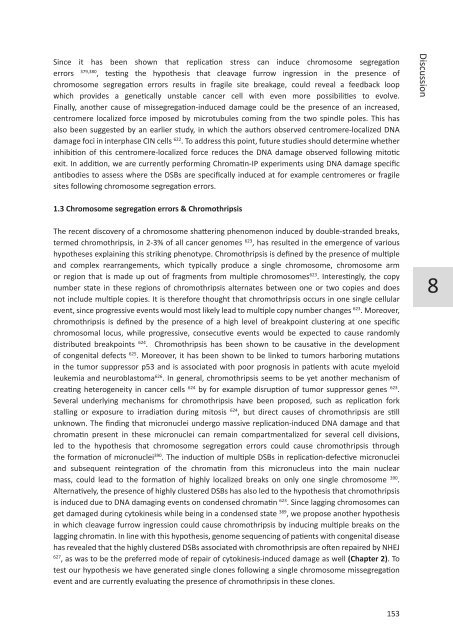Chromosome segregation errors: a double-edged sword - TI Pharma
Chromosome segregation errors: a double-edged sword - TI Pharma
Chromosome segregation errors: a double-edged sword - TI Pharma
Create successful ePaper yourself
Turn your PDF publications into a flip-book with our unique Google optimized e-Paper software.
Since it has been shown that replication stress can induce chromosome <strong>segregation</strong><br />
<strong>errors</strong> 379,380 , testing the hypothesis that cleavage furrow ingression in the presence of<br />
chromosome <strong>segregation</strong> <strong>errors</strong> results in fragile site breakage, could reveal a feedback loop<br />
which provides a genetically unstable cancer cell with even more possibilities to evolve.<br />
Finally, another cause of mis<strong>segregation</strong>-induced damage could be the presence of an increased,<br />
centromere localized force imposed by microtubules coming from the two spindle poles. This has<br />
also been suggested by an earlier study, in which the authors observed centromere-localized DNA<br />
damage foci in interphase CIN cells 622 . To address this point, future studies should determine whether<br />
inhibition of this centromere-localized force reduces the DNA damage observed following mitotic<br />
exit. In addition, we are currently performing Chromatin-IP experiments using DNA damage specific<br />
antibodies to assess where the DSBs are specifically induced at for example centromeres or fragile<br />
sites following chromosome <strong>segregation</strong> <strong>errors</strong>.<br />
1.3 <strong>Chromosome</strong> <strong>segregation</strong> <strong>errors</strong> & Chromothripsis<br />
The recent discovery of a chromosome shattering phenomenon induced by <strong>double</strong>-stranded breaks,<br />
termed chromothripsis, in 2-3% of all cancer genomes 623 , has resulted in the emergence of various<br />
hypotheses explaining this striking phenotype. Chromothripsis is defined by the presence of multiple<br />
and complex rearrangements, which typically produce a single chromosome, chromosome arm<br />
or region that is made up out of fragments from multiple chromosomes 623 . Interestingly, the copy<br />
number state in these regions of chromothripsis alternates between one or two copies and does<br />
not include multiple copies. It is therefore thought that chromothripsis occurs in one single cellular<br />
event, since progressive events would most likely lead to multiple copy number changes 623 . Moreover,<br />
chromothripsis is defined by the presence of a high level of breakpoint clustering at one specific<br />
chromosomal locus, while progressive, consecutive events would be expected to cause randomly<br />
distributed breakpoints 624 . Chromothripsis has been shown to be causative in the development<br />
of congenital defects 625 . Moreover, it has been shown to be linked to tumors harboring mutations<br />
in the tumor suppressor p53 and is associated with poor prognosis in patients with acute myeloid<br />
leukemia and neuroblastoma 626 . In general, chromothripsis seems to be yet another mechanism of<br />
creating heterogeneity in cancer cells 624 by for example disruption of tumor suppressor genes 623 .<br />
Several underlying mechanisms for chromothripsis have been proposed, such as replication fork<br />
stalling or exposure to irradiation during mitosis 624 , but direct causes of chromothripsis are still<br />
unknown. The finding that micronuclei undergo massive replication-induced DNA damage and that<br />
chromatin present in these micronuclei can remain compartmentalized for several cell divisions,<br />
led to the hypothesis that chromosome <strong>segregation</strong> <strong>errors</strong> could cause chromothripsis through<br />
the formation of micronuclei 390 . The induction of multiple DSBs in replication-defective micronuclei<br />
and subsequent reintegration of the chromatin from this micronucleus into the main nuclear<br />
mass, could lead to the formation of highly localized breaks on only one single chromosome 390 .<br />
Alternatively, the presence of highly clustered DSBs has also led to the hypothesis that chromothripsis<br />
is induced due to DNA damaging events on condensed chromatin 623 . Since lagging chromosomes can<br />
get damaged during cytokinesis while being in a condensed state 389 , we propose another hypothesis<br />
in which cleavage furrow ingression could cause chromothripsis by inducing multiple breaks on the<br />
lagging chromatin. In line with this hypothesis, genome sequencing of patients with congenital disease<br />
has revealed that the highly clustered DSBs associated with chromothripsis are often repaired by NHEJ<br />
627 , as was to be the preferred mode of repair of cytokinesis-induced damage as well (Chapter 2). To<br />
test our hypothesis we have generated single clones following a single chromosome mis<strong>segregation</strong><br />
event and are currently evaluating the presence of chromothripsis in these clones.<br />
153<br />
Discussion<br />
8













